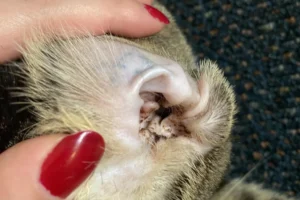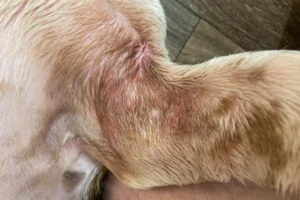Cats are beloved members of our families, but when they start scratching excessively, it can be a cause for concern. One common issue that may be the culprit is mites.
Why Does My Cat Have Mites?
Understanding Mites: What Are They and How Do Cats Get Them?
Mites are tiny, pesky creatures that can wreak havoc on your cat’s skin and ears. These microscopic pests can cause itching, irritation, and even infections if left untreated. Cats can get mites from other animals, like other cats or dogs, or from their environment. Outdoor cats are more at risk of picking up mites from the grass or soil, while indoor cats can still get them from shared bedding or contact with infested animals.
If you notice your cat scratching excessively, shaking their head frequently, or developing scabs or sores on their skin, they may have mites. It’s essential to take your furry friend to the vet for proper diagnosis and treatment to ensure their comfort and health. Don’t delay in addressing mites, as they can worsen and cause further issues for your cat if left untreated.
Symptoms of Mites: How to Tell If Your Cat Has Them
Identifying mites in your cat is crucial to providing them with the necessary care and treatment. Keep an eye out for common signs that may indicate your cat has mites. These can include intense scratching, head shaking, redness or inflammation of the skin, hair loss, or crusty patches on the skin.
Additionally, if you notice your cat excessively grooming a specific area or showing signs of discomfort, it’s essential to investigate further. A vet can perform a simple skin scraping test to confirm the presence of mites and recommend the best course of action for treatment.
Remember, early detection and intervention are key to preventing mites from causing serious discomfort and health issues for your beloved feline friend.
For more information on treating mites in cats, check out this helpful resource from the American Society for the Prevention of Cruelty to Animals: ASPCA – Mites in Cats.
Treatment Options: How to Get Rid of Mites in Cats
If you’ve noticed your furry pal scratching more than usual, mites might be the pesky culprits causing the itch. Don’t worry; there are several effective treatment options to help your cat get rid of these annoying intruders. The first step is always to consult your veterinarian for a proper diagnosis. Once the type of mite is identified, your vet may recommend topical treatments, oral medications, or even medicated baths to eliminate the mites. Additionally, keeping your cat’s living area clean and treating any other pets in the household is crucial to prevent mites from coming back. So, if your cat is suffering from mites, remember: a trip to the vet is the first important step in getting rid of these bothersome bugs!
Prevention Tips: How to Keep Your Cat Mite-Free
Prevention is key when it comes to keeping your beloved feline friend mite-free. To protect your cat from these tiny troublemakers, regularly groom and inspect your cat’s fur, as early detection can make a big difference. Additionally, wash your cat’s bedding frequently, vacuum your home regularly, and keep your cat’s living space clean and clutter-free. It’s also important to ensure your cat is on a nutritious diet to support a healthy immune system, which can help fend off mites. And here’s a unique tip: consider using a pet-safe essential oil spray as a natural repellent against mites. By taking these preventive measures, you can create a mite-free environment for your kitty to thrive in.
When to See a Vet: Seeking Professional Help for Mite Infestations
If you notice your cat scratching excessively, developing scabs or sores on their skin, or experiencing hair loss, it may be a sign of mite infestations. Ear mites can lead to head shaking or a foul odor from the ears, while fur mites can cause itching and irritated skin. In such cases, it’s crucial to consult a veterinarian promptly to address the issue effectively.
Seeking professional help is essential when home remedies fail to alleviate your cat’s discomfort. Veterinarians can accurately diagnose the type of mite infestation your cat is experiencing and recommend the most suitable treatment. They may prescribe medications such as topical solutions or oral medications to eliminate mites and relieve your pet’s symptoms.
Remember, mite infestations left untreated can lead to more serious health complications for your cat. Early intervention by a vet can prevent further discomfort and ensure your cat’s well-being. Therefore, observing any unusual behavior or symptoms in your cat signals the time to seek professional help promptly.
Helpful resource: American Association of Feline Practitioners.
The Relationship Between Mites and Other Health Issues in Cats
Did you know that mites not only cause skin irritation in cats but can also contribute to more severe health problems if left untreated? Mite infestations weaken your cat’s immune system, making them susceptible to secondary infections and allergic reactions. This can result in a vicious cycle of health issues for your feline friend.
Moreover, constant scratching and biting due to mites can lead to inflamed skin and open wounds, providing entry points for bacteria to cause infections. These infections can spread internally, affecting your cat’s organs and overall health. Therefore, addressing mite infestations promptly is crucial to prevent such complications.
Regular grooming and vet check-ups can help detect mite infestations early on and prevent them from escalating into more significant health concerns. By maintaining your cat’s skin and coat health, you can safeguard them from the detrimental effects of mites and ensure they lead a happy, healthy life. Keep an eye out for any changes in your cat’s behavior or appearance to catch mite-related health issues early on and address them effectively.
Fun Fact: Surprising Information About Mites and Cats
Did you know that mites are actually a common occurrence in the environment, and most cats have a few mites living on their skin without causing any issues? These microscopic creatures thrive in warm, humid environments, making your fuzzy feline the perfect host. So, it’s not uncommon for your cat to have mites, but it’s essential to address them promptly if they start causing discomfort or health issues.
When it comes to diagnosing mites in your cat, a veterinarian can perform a simple skin scraping test to identify the type of mite and recommend appropriate treatment to get rid of them for good. Remember, prevention is key, so keep your cat’s living environment clean and regularly groom them to reduce the risk of mites infestation.
Here is a useful tip: consider using preventive treatments like mite repellent shampoos or spot-on treatments recommended by your vet to keep those pesky mites at bay and your furry friend itch-free and healthy.
For more detailed information on how to deal with mites infestation in cats, check out this comprehensive guide from the American Society for the Prevention of Cruelty to Animals (ASPCA): ASPCA Guide to Mites in Cats
Alex, a passionate animal lover, has experience in training and understanding animal behavior. As a proud pet parent to two dogs and three cats, he founded AnimalReport.net to share insights from animal experts and expand his knowledge of the animal kingdom.









